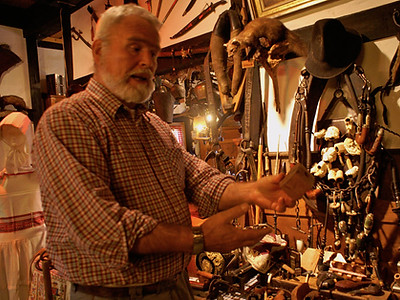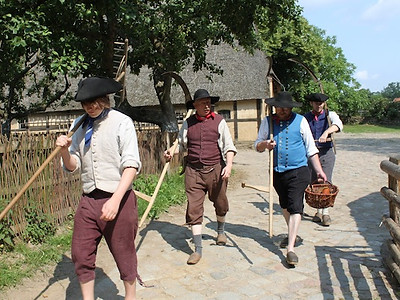Museums and exhibitions
in the Elbe region
Experience border towers -
from border history to border nature
Three border towers and a bunker
Traces and memories in Lower Saxony's Elbtalaue region
Archezentrum Amt Neuhaus
Elbstraße 11
19273 Neuhaus / Konau
Tel.: +49 38841 759 614
Biosphaerium Elbtalaue
Schlossstraße 10
21354 Bleckede
Tel.: +49 5852 951 414

Amt Neuhaus Archezentrum -
information centre for Lower Saxony Elbe Floodplain Biosphere Reserve
Free guided tours of the exhibition are available on a regular basis and for groups upon request.
Archezentrum Amt Neuhaus
Elbstraße 11
19273 Neuhaus / Konau
Tel.: +49 38841 759 614

Museum im Marstall
The museum in the Marstall is located in the heart of the city of Winsen (Luhe): The historic Marstall (horse stable) from 1599 is located directly on Schlossplatz in the vicinity of the moated castle.
The museum in the Marstall is operated by the Heimat- und Museumverein Winsen (Luhe) und Umgebung e. V.
It is presented on four floors and is handicapped accessible. On the ground floor, visitors will find the checkout area with a small but fine museum shop. On the first floor, the new permanent exhibition shows the regional characteristics: The Elbmarsch culture with the precious embroidery, the wonderful inlays, the work of the painter Hugo Friedrich Hartmann and well-known personalities of the region, such as Johann Peter Eckermann, Hugo Haase and Schäfer Ast. Changing special exhibitions take place on the 2nd floor and a walk-in timeline welcomes visitors to the 3rd floor. From the Stone Age to the present, modules provide information on life in bygone eras.
The calendar of events as well as other offers of the museum can be found at www.museum-im-marstall.de .

Elbe Floodplain Biosphaerium
Anyone who has always wanted to get to know one of the most famous inhabitants of the Elbe and its tributaries visits the beavers in the Biosphaerium. Watching them in the water, on land or in their castle is a special experience. In addition, there are over 25 Elbe fish species swimming in a large aquarium landscape: the eel meanders and the zander and catfish stay still. Individual pools show the different waters in the floodplain. The extensive exhibition on the diverse bird life of the Elbe Valley is also impressive. And visitors are always invited to actively participate, for example with birdcall piano or the red kite game.
Click here for the exhibitions:

Dahlenburg Local History Museum
In 1928, a museum was set up in the former St. Laurent chapel, which dates back to the 13th century and was the remnants of an old castle complex. The mighty castle chapel is now looked after by the museum association. Around the historic building, museum festivals take place with folk groups and historical crafts. Today, the museum houses not only pre-historic and early-historical collections, but also finds and a diorama from the battle of the Göhrde. Every two years, the "Göhrde battle" rages in memory of the only victorious battle of an alliance against Napoleonic troops on North German soil, with open-air theatre in Dahlenburg. The next spectacle will take place in 2015.

Hohnstorf Fishery Museum
This fishing village on the Elbe is directly opposite Lauenburg. On the Elbe promenade you look over the magnificent timber-framed facade. Hohnstorf is known for its lively village structure and animal-rich nature. Elbe fishermen still go fishing from here, and this is shown lovingly by the small Elbe Fishing Museum, with its extensive collection of items and exhibits.
www.fischereimuseum-hohnstorf.de

Konau and Popelau - border stories
Konau and Popelau are the best-preserved linear villages (hufendörfer). Like curious half-houses, the houses peer out from the two villages beyond the long Elbe dyke. The farmers lived in prosperity for centuries. Their cattle and horse breeding were famous. The living quarters of the houses of a linear village pointed to the water, the business area and the fields away from the water. Only one complete linear village has survived worldwide: Konau. Since 1952, marginal Elbe villages were in the restricted area. For EXPO 2000, the emotional border history of Popelau and Konau was worked on, which is explained today by two exhibitions on the history of the border and in a cross-border tour.
.jpg)
Beck Farm Museum
The farm museum in Nahrendorf
In a dilapidated farmhouse cottage from the 18th century, the Becks created a very special home, which they like to share with others. For many years they have collected exhibits from the "good old days". Gramophones, beautifully embroidered bags, and a 19th century dentist's chair are just a few examples. In addition, the landlord tells delightful stories.

Rose garden near Seevetal:
The Open-air Museum on Kiekeberg
The open-air museum on Kiekeberg is the central cultural institution in Harburg district. The focus of our work is collecting, preserving, exploring, and conveying testimonies of the cultural history of Lüneburg Heath and Winsen Elbe Marsh.

Forest Museum - Göhrde Naturum
Learn about the forest, get to know Göhrde and local history. Enjoy the countryside, leave the hustle and bustle of everyday life behind. It is not only on our nature trail that there is so much to discover... Today's museum building was built in 1672 and was a "Celler stable" to the former Göhrde hunting lodge. When hunting in Göhrde flourished again in 1837 under King Ernst August, the building was renovated. From 1869 it served as accommodation for forestry officials and forest workers.

Open-air Museum - Hitzacker
Archaeological Centre - Experience and Understand Archaeology
In the north-east of Lower Saxony, where Jeetzel and Elbe meet, lies the town of Hitzacker (Elbe). Archaeologists discovered traces of a prehistoric settlement here back in 1969. The settlement existed over 1,300 years (from the Late Stone Age to the Bronze Age). Today the archaeological open-air museum is located here, which opened its doors in 1990. Embedded in a natural park area, there are five buildings and many stations on the life, works and beliefs of the early settlers on an original scale. Children and adults alike can experience with all their senses what everyday life might have been like at that time. Various action programs - combinable with overnight stays in one of the longhouses - let our guests immerse themselves in the life and work of the people 4,000 years ago.

Hitzacker: The Old Customs House
Here visitors will learn interesting facts about the eventful history of the town, which is surrounded by water and often threatened by the river Elbe. In addition to the history of the Customs House, the Elbe customs, the story of the robber baron Riebe on the castle vineyard, or everyday urban happenings, the visitor goes on a journey through time to the recent past and can imagine how the border issue challenged the people here. In addition, shipbuilding, shipping, and hydraulic engineering played a central role over the centuries.

Boizenburg: First German Tile Museum
The museum collects and presents mainly artistically designed tiles from industrial production, from the beginning of the 20th century to the present day. At tile exchanges, anyone can admire, swap, buy, and sell rare tiles. Changing exhibitions show the tile in certain eras, such as Art Nouveau and Art Deco, document the history of the tile as a utility and art object, provide insights into the tile art of other countries, and the collected tile treasures of known German manufacturers.


